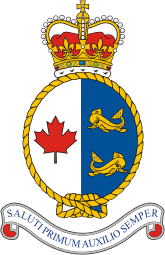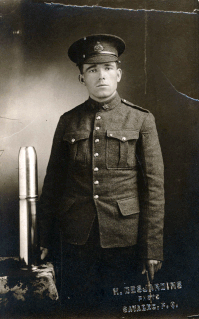
Joseph Thomas Keable, VC, MM was a Canadian soldier during the First World War. Keable was a recipient of the Victoria Cross, the highest and most prestigious award for gallantry in the face of the enemy that can be awarded to British and Commonwealth forces. He was the first French Canadian soldier to be decorated with the VC and Military Medal.

James Peter Robertson was a Canadian recipient of the Victoria Cross, the highest and most prestigious award for valour in the face of the enemy that can be awarded to British and Commonwealth forces.

CCGS Louis S. St-Laurent is a Canadian Coast Guard Heavy Arctic Icebreaker. Louis S. St-Laurent's home port is St. John's, Newfoundland and Labrador and is stationed there with other vessels of the coast guard.
The North Nova Scotia Highlanders was an infantry regiment of the Canadian Army.

CCGS Sir William Alexander is a Martha L. Black-class light icebreaker. Entering service in 1987, the vessel is currently assigned to CCG Maritimes Region and is homeported at CCG Base Dartmouth, in Dartmouth, Nova Scotia. The vessel is named after Scottish explorer Sir William Alexander, 1st Earl of Stirling, who was an early colonizer of Nova Scotia.
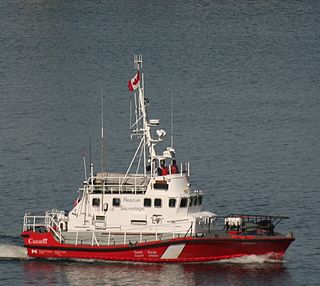
CCGS Westport is a Canadian Coast Guard search and rescue vessel homeported in Westport, Nova Scotia.

The National Search and Rescue Program (NSP) is the name given by the Government of Canada to the collective search and rescue (SAR) activities in Canada. Until 2015, the NSP was administered by the National Search and Rescue Secretariat (NSS).

CCGS Hudson is an offshore oceanographic and hydrographic survey vessel operated by the Canadian Coast Guard. The ship entered service in 1963 with the Canadian Oceanographic Service, stationed at the Bedford Institute of Oceanography, called CSS Hudson. The ship made several significant scientific voyages, among them the first circumnavigation of the Americas in 1970. The ship was transferred to the Canadian Coast Guard in 1996 and remains in service.

CCGS Alfred Needler is an offshore fishery science vessel operated by the Canadian Coast Guard. The vessel entered service in 1982 with the Department of Fisheries and Oceans, stationed at the Bedford Institute of Oceanography in Dartmouth, Nova Scotia. In 1995, in order to reduce the number of ships and combine tasks, the Fisheries and Oceans fleet and the Canadian Coast Guard fleets were merged under the Canadian Coast Guard. Alfred Needler is currently in service.

CCGS Sambro is a Canadian Coast Guard motor lifeboat homeported in Sambro, Nova Scotia.
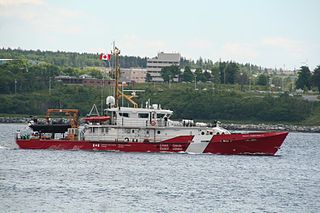
The Hero-class patrol vessels, previously the Mid-Shore Patrol Vessel Project, is a series of nine patrol vessels constructed by Halifax Shipyards for the Canadian Coast Guard. Based on the Dutch Damen Stan 4207 patrol vessel, construction began in 2011 and the first vessel entered service in 2012. The vessels are assigned to both coasts of Canada, used for coastal patrol duties.

The Canadian Coast Guard has had two motor lifeboats named CCGS Clarks Harbour. The first was a 13-metre (43 ft) vessel, which entered service in 1996.
CCGS Simon Fraser was a buoy tender operated by the Canadian Coast Guard. The vessel entered service in 1960 with the Department of Transport's Marine Fleet, before being transferred to the newly formed Canadian Coast Guard in 1962. The buoy tender served on both coasts of Canada and was used for search and rescue duties along the West Coast of Canada. The ship was loaned to the Royal Canadian Mounted Police in 2000 and transited the Northwest Passage, circumnavigating North America in the process. The ship was taken out of service in 2001 and sold to private interests. In 2006, the vessel reappeared as a yacht using the same name.
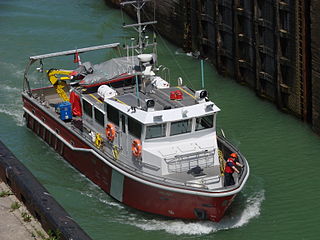
ABCO Industries is located on the waterfront of the UNESCO World Heritage Site-designated port town of Lunenburg, Nova Scotia.

CCGS Captain Goddard M.S.M. is one of the Canadian Coast Guard's nine Hero-class patrol vessels. The ship entered service in 2014 and is based at Victoria, British Columbia on Canada's West Coast. The vessel's primary roles will be fishery and environmental patrols, border control, search and rescue.

CCGS Corporal Teather, C.V. is the third of nine of the Canadian Coast Guard's Hero-class patrol vessels. Constructed in 2013, the ship entered service the same year. Corporal Teather C.V. is based in Sarnia, Ontario, tasked with enforcing Canadian maritime law within Canadian borders.
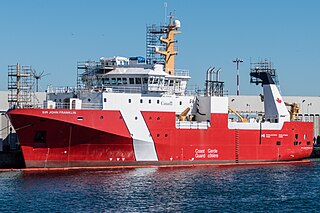
CCGS Capt. Jacques Cartier is an offshore fisheries research ship of the Canadian Coast Guard. The ship was ordered in 2011 as part of the Canadian National Shipbuilding Procurement Strategy (NSPS) as a replacement for aging Canadian Coast Guard vessels. Capt. Jacques Cartier is the sister ship of CCGS Sir John Franklin and CCGS John Cabot. The ship was constructed at Seaspan Shipyard, Vancouver, British Columbia and launched on 5 June 2019.
